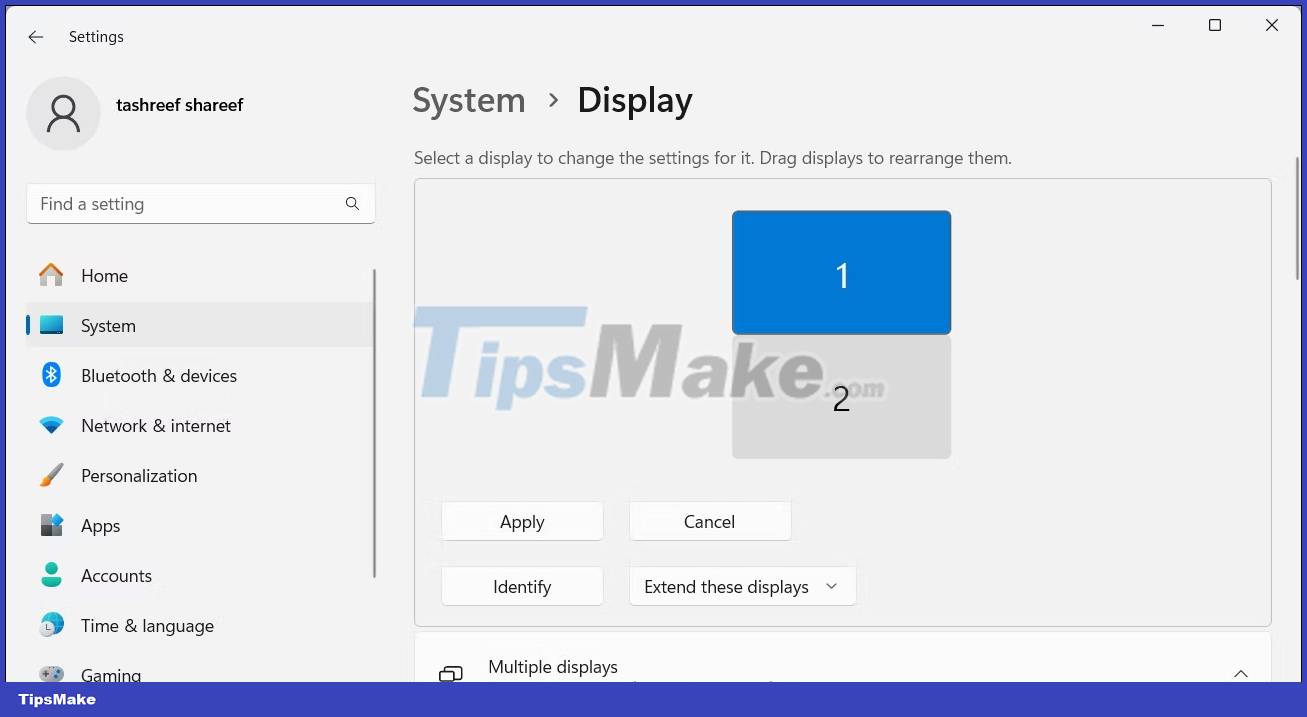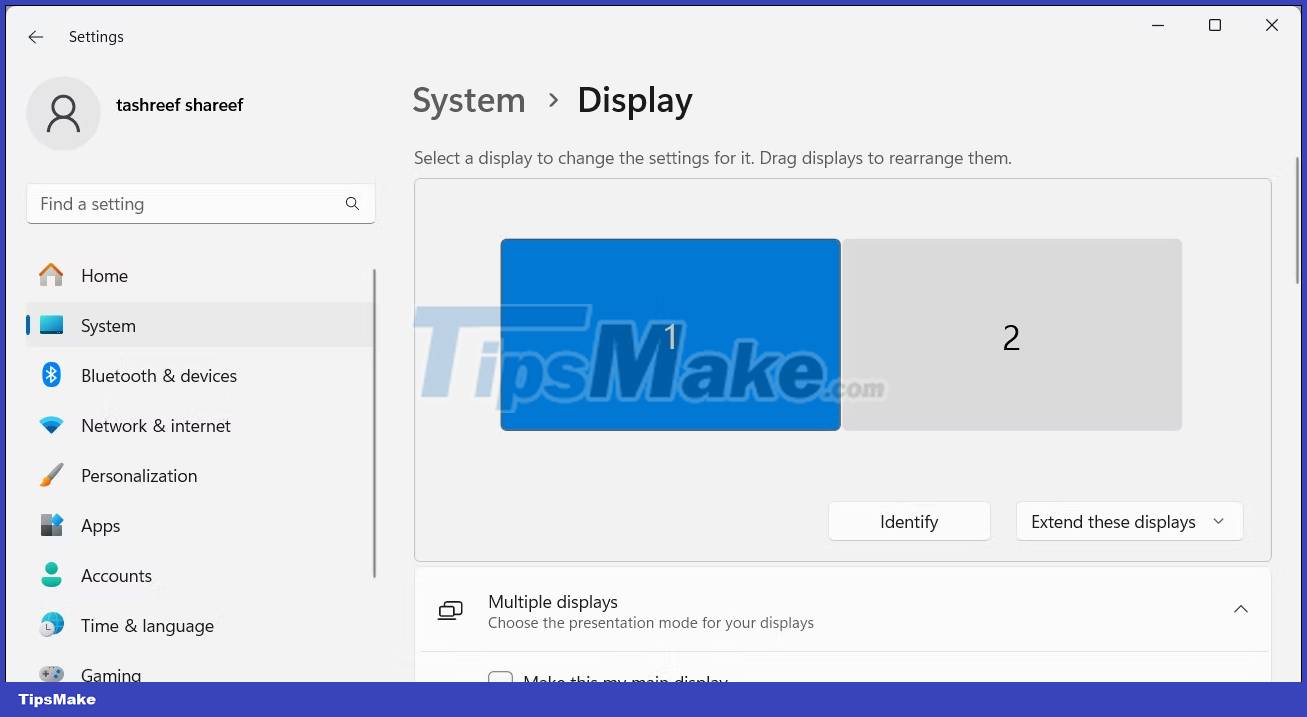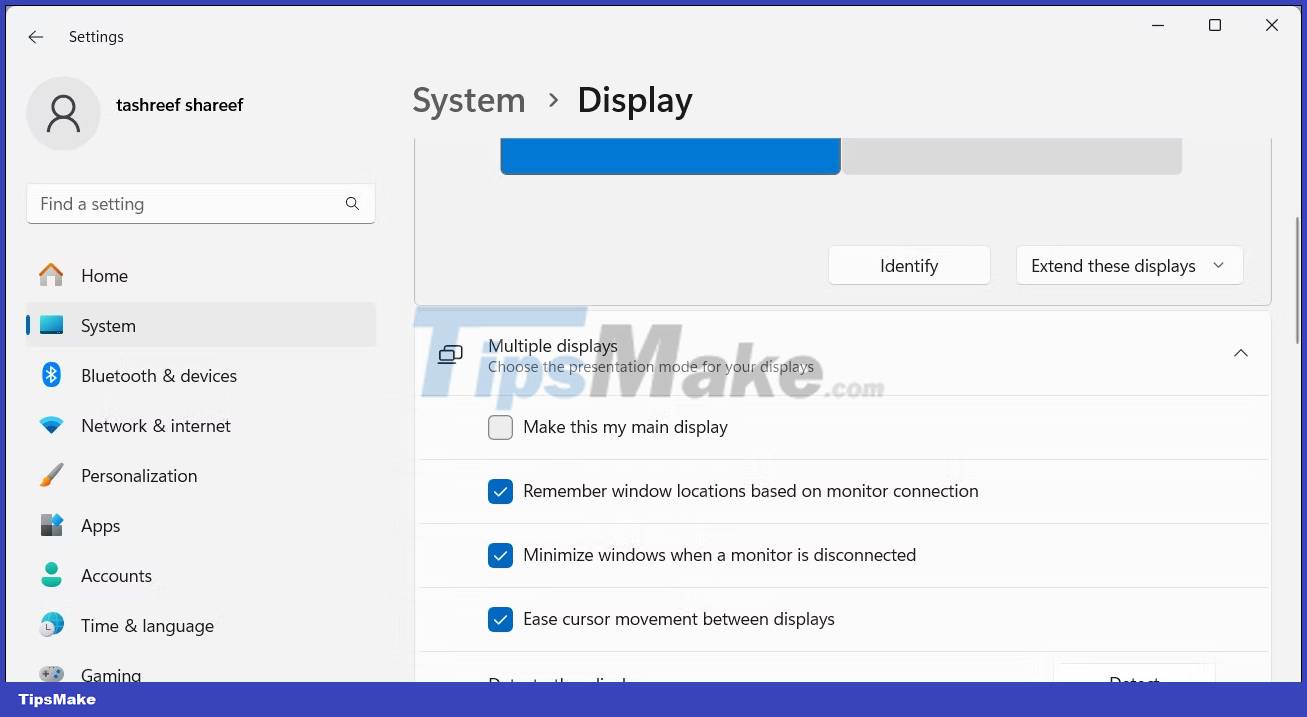How to change monitors 1 and 2 in Windows
In Windows 10 and 11, you can rearrange multiple displays connected to your computer to reflect their physical arrangement. Similarly, you can also configure any display as your primary display. Here's how to change the position of monitors 1 and 2 and set the primary monitor in a multi-monitor setup in Windows.
How to change monitors 1 and 2 on Windows
A common problem when setting up dual monitors is when you need to move the mouse pointer to the left side of the screen to get to the second monitor. You can fix this by rearranging the display to reflect its physical layout. To swap displays 1 and 2:
1. Press Win + P to open the Project menu, then select Extend to extend your desktop across multiple monitors. If you can't extend your display, make sure you've configured your dual-monitor setup correctly.

2. Right-click on an empty area of your desktop and select Display Settings. Alternatively, go to Settings > System > Display.

3. In Display settings, click Identify. Windows will display numbered boxes on your screen to help you identify screens 1 and 2 (as well as other screens, if you have more than two).

4. To rearrange the displays, drag each display to the left/right or top/bottom position to duplicate your physical setup. For example, if you have a vertical dual monitor setup where monitor 2 is placed below monitor 1, drag and position monitor 1 above monitor 2 to mimic the physical layout.

5. Click Apply to save the new display settings. Now, try moving the cursor across the screens to test the new setup. The change will feel seamless.
How to set up a home screen in Windows
The home screen displays the taskbar, desktop icons, notifications, system tray, and quick settings panel. This is also where most new apps will open by default. If you want to change your home screen so that all your important content appears there, you can do this from the Settings app.
To set the default display on a dual monitor setup:
1. Press Win + I to open Settings.
2. Open the System tab and select Display.

3. Here, select the screen you want to set as your primary screen.
4. Click to expand Multiple displays to see more options.

5. Select the Make this my main display option. Once completed, Windows will move the taskbar items, system tray, desktop icons, and notifications to your home screen.
Rearranging screens to reflect their physical layout is necessary to ensure that your cursor moves easily between screens. Additionally, setting your home screen will ensure your taskbar and desktop icons appear on the screen you want. You should also consider using the best dual monitor management apps to further enhance your multi-monitor setup experience.
You should read it
- How to Set Different Wallpapers on Dual Monitors on Windows
- How to use 2 screens on a computer
- How to Set Up Two Computer Monitors
- How to use 2 monitors on Windows 10
- How to adjust the light of multiple screens with the Twinkle Tray
- How to install 2 monitors on a Mac computer
- How to change the presentation mode for screens in Windows 10
- Top 5 best gaming monitors 2020
May be interested
- How to Use Two Monitors with Windows 8
 windows 8 makes it easier than ever to connect two or more monitors to your pc, which can greatly enhance the user experience and increase your productivity. there's no need to throw away an old screen when you upgrade, just use it to...
windows 8 makes it easier than ever to connect two or more monitors to your pc, which can greatly enhance the user experience and increase your productivity. there's no need to throw away an old screen when you upgrade, just use it to... - How to use multiple computer monitors at the same time effectively
 arranging, using software, adjusting the mouse ... are methods to help increase the multi-screen experience for computer users.
arranging, using software, adjusting the mouse ... are methods to help increase the multi-screen experience for computer users. - How to set up different wallpaper images on each Windows 10/11 screen
 setting up multiple monitors on windows is quite simple and only takes a few minutes to do. once you have set up multi-monitor mode (multiple monitors), you can set up individual wallpapers for each monitor. to do this, please refer to the article below from network administrator.
setting up multiple monitors on windows is quite simple and only takes a few minutes to do. once you have set up multi-monitor mode (multiple monitors), you can set up individual wallpapers for each monitor. to do this, please refer to the article below from network administrator. - Instructions for connecting two monitors on the MacBook
 due to business needs, we need to connect macs together, so we can use 2 monitors at the same time. thus your work will increase much more effectively.
due to business needs, we need to connect macs together, so we can use 2 monitors at the same time. thus your work will increase much more effectively. - How to use multiple external monitors on Ubuntu
 like on any operating system, using a second screen on linux can help you work more efficiently or immerse yourself deeper into the virtual world when gaming.
like on any operating system, using a second screen on linux can help you work more efficiently or immerse yourself deeper into the virtual world when gaming. - How to fix the screen skew when using 2 monitors
 screen deviation is a common error when you use multiple monitors on 1 computer. this error causes the mouse to move back and forth between the 2 screens, which is not correct on the same line.
screen deviation is a common error when you use multiple monitors on 1 computer. this error causes the mouse to move back and forth between the 2 screens, which is not correct on the same line. - 5 best 1440p monitors for gaming
 1440p monitors, also known as 2k monitors, are a great choice, especially for gaming. it's not as sharp as 4k, but is a significant upgrade from 1080p.
1440p monitors, also known as 2k monitors, are a great choice, especially for gaming. it's not as sharp as 4k, but is a significant upgrade from 1080p. - Are curved monitors good? The difference between curved monitors - flat monitors
 are curved monitors good? what are the advantages of curved monitors? learn the difference between curved monitors and flat monitors.
are curved monitors good? what are the advantages of curved monitors? learn the difference between curved monitors and flat monitors. - 5 main notes when using multiple screens with a laptop
 do you find yourself switching between windows too often or cramming multiple windows on your laptop screen? it's time to get a second monitor!
do you find yourself switching between windows too often or cramming multiple windows on your laptop screen? it's time to get a second monitor! - How to change SDR and HDR light balance in Windows 10
 when connecting an hdr10-capable monitor or tv to a windows 10 pc that supports hdr and wcg colors, you get a brighter, more vibrant picture and more detail than the standard sdr screen.
when connecting an hdr10-capable monitor or tv to a windows 10 pc that supports hdr and wcg colors, you get a brighter, more vibrant picture and more detail than the standard sdr screen.










 How to install Windows on Steam Deck
How to install Windows on Steam Deck Why doesn't Word have dictate? How to fix?
Why doesn't Word have dictate? How to fix? 15 diagnostic tools to check Windows PC health
15 diagnostic tools to check Windows PC health How to fix Windows 10 not booting error
How to fix Windows 10 not booting error Snipping Tool cannot be used, summarize effective ways to fix it
Snipping Tool cannot be used, summarize effective ways to fix it 8 best RSS reading applications for Windows
8 best RSS reading applications for Windows